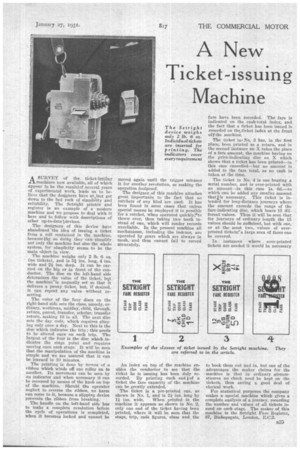A New Ticket-issuing Machine
Page 43

If you've noticed an error in this article please click here to report it so we can fix it.
ASURVEY of the ticket-imting machines now available, all of which appear to be the resultl of several years of experimental work, leads us to believe that the designers have at,,last got down to the bed rock of simplicity and reliability. The Setright printer and register is an example of a modern machine and we propose to deal with it here and to follow with descriptions of other up-to-date t devices.
The designers of this device have abandoned the idea of issuing a ticket from a roll contained in the machine, because /by so doing they can simplify not only the machine but also the whole system, for simplicity seems to be the main object in view.
The machine weighs only 2 lb. 6 oz. (no tickets), and is 51 ins. long, 4 ins. wide and 2k ins. deep. It can be carried on the hip or in front of the conductor. The disc on the left-hand side determines the value of the ticket, bit the machineis normally set so that it delivers a penny ticket, but, if desired, it can repeat any value without resetting.
The outer of the four discs on the right-hand side sets the class, namely, ordinary, workman, midday; child, through, return, parcel, transfer, scholar, transfer return, making 10 in all. The next disc sets the day code, which requires altering only once a day. Next to this is the disc which indicates the trip ;.this needs to be altered once on each trip. The largest of the fotir is the disc which indicates the stage point and requires moving once each stage. It will be seen that the manipulation of the machine is simple and we are assured that it can be learned in 10 minutes.
The printing is done by means of a ribbon which winds off one roller on to another. Its movement can be seen by an indicator and when necessary it can be reversed by means of the knob on top of the machine. Should the operator neglect to reverse the ribbon, no harm can come to it, because a slipping device prevents the ribbon from breaking.
The handle on the left-hand side has to make a complete revolution before the cycle of operations is completed, when it becomes locked and cannot be moved again until the trigger releases it for another revolution, so making the operation foolproof.
The designer.of this machine attaches great imp ortanee to the fact that no ratchets of any kind are used. It bas been found in some cases that unless special means be employed it is possible for a ratchet, when operated quickly;*to throw over, thus taking two teeth instead of one, which will render records unreliable. In the present machine all mechanisms, including the indexes, are operated by gears which are always in mesh, and thus cannot fail to record accurately.
An index on top of the machine enables the conductor to see that the ticket he is issuing has been duly recorded. By printing each end I of a ticket the fare capacity of the machine can be greatly extended.
The ticket is a pre-printed one, as shown in No. 1, and is 21 ins, long by 1i ins. wide. When printed in the machine it appears as shown in No. 2, only one end of the ticket having been printed, where it will be seen that the stage, trip, code figures, class and the
fare have been recorded. The fare is indicated on the cash-total index, and the fact that a ticket has been issued is recorded on the ticket index at the front of I the machine.
The ticket in, No. 3 has, in the first place, been printed as a return, and in the second instance an X takes the place of a fare amount, the machine having on the price-indicating disc an X which shows that a ticket has been printed—ia this case caneelled--but no amount is added to the fare total, as no cash is taken at the time.
The ticket in No. 4 is one bearing a serial number, and is over-printed with an amount—in this ease Is. 6d.—to which can be added any smaller amount thattis necessary. This ticket is intended for long-distance journeys where the amount exceeds the range of the fare-indicating disc, which bears 15 different values. Thus it will be seen that for journeys of ordinary length the 15 values should be sufficient, but with one, or at the most two, values of overprinted tickets -,'a large area of fares can be covered.
In instances where over-printed tickets are needed it would be necessary to book them out and in, but one of the advantages the maker claims for the machine is that in ordinary circumstances no check need be kept on the tickets, thus saving a good deal of clerical work.
For statistical purposes the company makes a special machine which gives a complete analysis of a journey, recording the number and values of all tickets issued on each stage. The maker of this machine is the Setright Fare Register, 87, Bishopsgate, London, B.C.2.




































































































